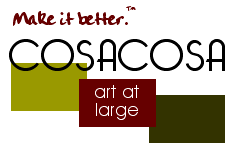



Volcanic imagination, voluptuous sensitivity, dynamic inventiveness are called artistic because we -- as a society -- do not know how to deal with the phenomenon of creative approach to oneself and to one's surrounding environment -- to the natural world, to culture-at-large. Hence, we are doomed to apply ready-made terms according to assigned and compartmentalized social roles and functions. In the same fashion, we encase postmodernists as artists because we lack any other well-suited labels. The difference between true artists and postmodernists (or other art product-producers) has nothing to do with whether they create art or not. Artists are Eternal Fighters -- challenging the status quo, advancing our awareness, breaking bounds and barriers.
More typical, more comfortable, more recognizable as artists are those who choose to swim with the prevailing current; their main objective to say "Here we are." They identify themselves proudly as the standard-bearers of a blasphemous and empty reality. Their sham-art, whose target is most often a great, round sum of dollars, comes from no-where and further codifies society's prescribed roles for art. True artists, if they were priests, would be for a theology of liberation. If they were philosophers, they would look for a Harbor of Being or develop a neo-dada epistemology. If they were scientists, they would rather ask new questions than provide new micro-answers to old ones. True artists today, as they were in ancient times, are the bearers of a difficult aesthetic -- one necessary to evolution of our collective consciousness -- an anti-art.
A splendor, tangible and spiritual, radiates from this anti-art (or, strictly speaking, beyond-art). We as artists must remain faithful to this path. Our stake* is the meaning of human existence -- a precise duet and duel with the present day world.
*stake, a piece of wood sharpened at one end for driving into the ground as a support; an upright pole or post fixed in a socket to confine a load; a small anvil used by blacksmiths; a post on which a skin is stretched for currying or graining; something risked or hazarded, as in a wager, game or contest; a reward given a winner; a race in which a prize is offered; a share or interest in property or a person; a territorial division for ecclesiastical purposes, presided over by three high priests
at stake, being risked or hazarded, or dependent upon the outcome of something specific or implied
to die at the stake, an execution by burning
to have a stake in, to have a financial or economic interest in
to have at stake, to have at risk or hazard, to gamble
to pull up stakes, to change one's place of residence, business, etc.
stake all, to bet all for all
stake out, to mark the limits or boundaries of by or as by stakes, specifically as to establish a claim
stake boat, a vessel anchored as a mark
stake body, a flat body having sockets into which stakes may be fitted as support railings
stake driver, the American bittern: so named because its note resembles the sound produced in driving a stake into the ground
stakehead, in rope making, a horizontal bar supported by posts, stationed at intervals in the length of a ropewalk, to support yarns while spinning
stakeholder, one who holds stakes when a wager is made by others and pays it to the winner
stake truck, a carrier having a stake body
Stakhanovism, (after Aleksei F. Stakhavo, Soviet miner who initiated it in 1935) an efficiency system in which workers voluntarily increase their production by improvement of techniques and are rewarded with bonuses and privileges.
Marcos Kurtycz (1934-1996) was a Polish expatriate based in Mexico City. Kurtycz created numerous interdisciplinary artworks, installations, books, and posters featured in venues throughout Europe, Asia and the Americas, including COSACOSA. His "anti-art" performances, from the late 1970s to mid-1990s, influenced many artists of a new generation.